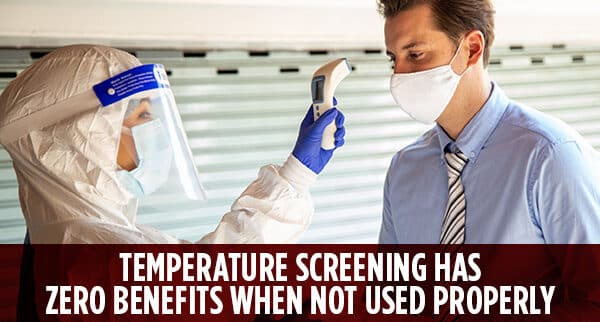Now that several months have passed since the initial implementation of temperature screening as a COVID-19 mitigation strategy, we’ve observed firsthand the benefits and best practices in using these systems effectively. Using these systems effectively is especially vital now that COVID-19 spikes are increasing throughout the nation. While these systems are not a means to detect or diagnose infectious diseases, they can detect elevated body temperatures that reach the CDC’s threshold for a definition of fever, which can allow security personnel to decide if an additional medical evaluation is needed.
What are the benefits?
Automated body temperature detection systems could be one of several tools implemented in a business’ reopening and operating efforts. They are non-invasive, quick, cost-effective, and accurate in screening for elevated body temperatures associated with COVID-19 when set up and used correctly. The rapid screening rate enables you to screen employees and patrons in short succession. It can be implemented remotely – meaning it won’t require a staff member or other trained person(s) to screen individuals in close proximity. Since these are digital systems, the screening data can be stored and sent to key team members safely and securely.
Best practices for elevated body temperature screening?
How to prepare the environment
There are many considerations to make before deploying a temperature screening system in your business. Consider where you’ll use the system: Are you using it at an entrance to monitor individuals entering or will you use it inside the building to monitor temperatures multiple times throughout the day?
Keep in mind, most of these systems will utilize a blackbody calibration device to maintain a constant temperature reference point in environments with fluctuating temperature and humidity levels. If your system doesn’t use a blackbody calibration, you’ll likely be required to recalibrate the system more frequently. It is best to use the system in an indoor area and a neutral location away from anything that might interfere with the reading, such as heaters, heat-emitting lights, sunlight, windows, air conditioning units, doorways, etc. The FDA suggests room temperatures from 68⁰ and 76⁰ F (20-24⁰ C) and a relative humidity level of 10%-50%. A thermal imaging device specialist can help you decide the best location for setting up your screening system so that it will function optimally.
How to prepare the subject
There are also some best practices for the individuals being screened by the devices to ensure the most accurate and effective reading. Already, many systems prompt users with steps and best practices on-screen within the screening procedure.
The subject’s face cannot be obstructed with hair, hats, or sunglasses. New AI-based software enables systems to not require the removal of face masks and detect and alert if the user is not complying with wearing a mask.
It’s important to note that the surface temperature of a user’s skin is altered due to factors such as cold or hot weather and perspiration, making it difficult to measure whether they have an elevated temperature accurately. Regulating the flow of users by postponing screening for several moments until their skin temperature normalizes is recommended. You may wish to utilize this waiting period for other screening methods such as a health questionnaire or checking to ensure individuals are wearing a face mask and practicing social distancing.
We have the solution for you
We’ve believed from the beginning that when utilized with multiple mitigation strategies and installed and operated with best practices in place, an elevated body temperature monitoring system can provide greater peace of mind to anyone entering a publicly or heavily occupied business. APL is here to help you create a safer workplace environment.
For more information about our recommended temperature screening systems, call us today. 1-866-873-2288


Leave a Reply
You must be logged in to post a comment.